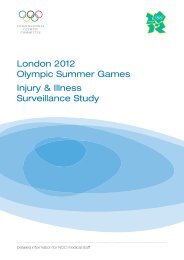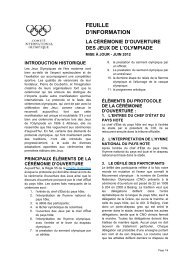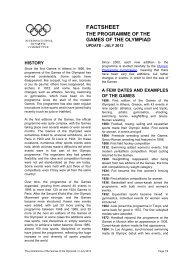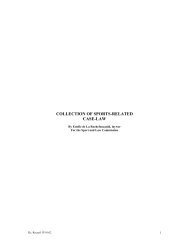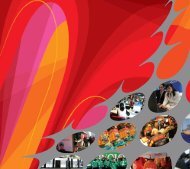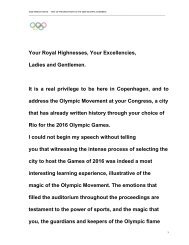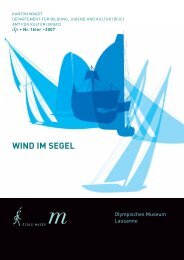8th WORLD CONFERENCE ON SPORT AND THE ENVIRONMENT
8th WORLD CONFERENCE ON SPORT AND THE ENVIRONMENT
8th WORLD CONFERENCE ON SPORT AND THE ENVIRONMENT
Create successful ePaper yourself
Turn your PDF publications into a flip-book with our unique Google optimized e-Paper software.
Mr Matt Dolf,<br />
Assistant Director, AISTS<br />
<strong>8th</strong> World Conference on Sport and the Environment<br />
International Cooperation and Development Department<br />
Report<br />
Mr Dolf described the AISTS, its mission to develop knowledge in sport, its initiatives in sustainability<br />
(including developing the SSET in partnership with VANOC, having research projects with sports<br />
federations and events).<br />
The rationale for the project: In a survey of sports organisations, only a small percentage had<br />
a written policy on environmental sustainability, and many stated that events were the highest<br />
priority.<br />
Topic: Leadership and Management<br />
by Mr Sean Maw (Speed Skating Canada Board Member)<br />
– Speed Skating Canada’s Sustainability Initiative<br />
SSC is the national organisation that administers the sport of speed skating in Canada.<br />
Mr Maw discussed how SSC created a Sustainability Committee and a Sustainability Policy. It started<br />
with him teaming up with Kristina Groves (Canadian speed skater) to create a Green Plan, which<br />
led to an analysis of the footprint of the SSC, and this was the springboard to having the rest of the<br />
Board undertake this initiative. An ad-hoc Sustainability Committee was created, with the mandate<br />
to formulate policies, programmes, and procedures that embed sustainability within SSC.<br />
Challenge: Mr Maw has found that it has been diffi cult to get started during the peak period<br />
preparing for the 2010 Winter Games (both staff and athletes). As a result, the Core and Advisory<br />
Committees have started slowly.<br />
Achievements:<br />
1. SSC has investigated the broad use of video teleconferencing to reduce both the environmental<br />
footprint of the organisations and travelling and meeting expenses.<br />
2. It will also be offering athletes options for taking leadership roles in the Clean Air Programme<br />
that connects with 2010 host communities.<br />
3. The key point about stakeholder input: The Core Sustainability Committee comprises only<br />
seven or eight people, and Ms Groves and other members cannot commit full time. Many others<br />
wanted to help, so an Advisory Committee was created and it receives all the materials about<br />
what SSC is doing. Advisory members do not need to respond if they don’t want to, but it has<br />
done a great deal of work. This dual committee model has resulted in a great deal of input from<br />
many stakeholders.<br />
Key message:<br />
1. State a commitment<br />
2. Get started<br />
3. Check progress.<br />
Key questions:<br />
1. Who in the organisation is the representative?<br />
2. What is the plan for the future?<br />
3. How will it be rolled out?<br />
Page 18 / 80






